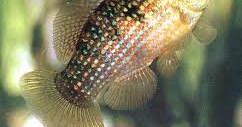Synodontis lucipinnis can most definitely be algae eaters (mine certainly are), and S. petricicola along with most Synodontis are reported as such in nature. (adults) My group of 8 wild caught adult S. lucipinnis cleaned a 125 of algae overnight. Every rock, nook and cranny was cleaned off, and this group had been in captivity for a few years at that point.
TAXONOMIC REVISION OF LAKE TANGANYIKAN SYNODONTIS (SILURIFORMES: MOCHOKIDAE)
Jeremy J. Wright1 and Lawrence M. Page1
ABSTRACT
The taxonomy of the Synodontis of Lake Tanganyika was investigated by examining 312 museum specimens. Morphometric, meristic, and nontraditional internal and external characters were examined, resulting in the recognition of 11 species of Synodontis from Lake Tanganyika. Ten of the species are endemic to the lake basin, and three are new to science. Synodontis grandiops n. sp. is most similar to S. multipunctatus but is distinguished by measurements of the eye (64.2-81.0% of snout length vs. 44.9-62.0% in S. multipunctatus) and pectoral-fin ray counts (7 vs. 8 in S. multipunctatus). Synodontis lucipinnis n. sp. is most similar to S. petricola but is distinguished by the lack of an axillary pore and the presence of light-colored windows at the bases of the rayed fins. Synodontis ilebrevis n. sp. is most similar to S. polli but is distinguished by the absence of a hindgut chamber, the shortness of the gut (0.8-1.4 times TL in S. ilebrevis vs. 4.0-5.5 times TL in S. polli), and the presence of short, flattened papillae on the skin (vs. villous papillae in S. polli).
Under the S. petricola profile ………..
Diet. – Young individuals appear to be primarily carnivorous, subsisting mainly on hydracarians, ostracods and insect larvae (trichopterans, chironomids) (Matthes 1959).
Adults feed on algae scraped from rocky substrates, and small invertebrates (Matthes 1959, Coulter 1991a).
In the above paper they also state:
"Many other Tanganyikan species of Synodontis prey largely on mollusks and algae scraped from rocky substrates." S. lucipinnis diet is simply listed as "unknown".
In my experience, captive bred lucipinnis/petricola that are born & raised, and kept well fed in captivity, may not choose to eat algae, but wild caught specimens will mow that algae down like a John Deere on steroids.
HTH








